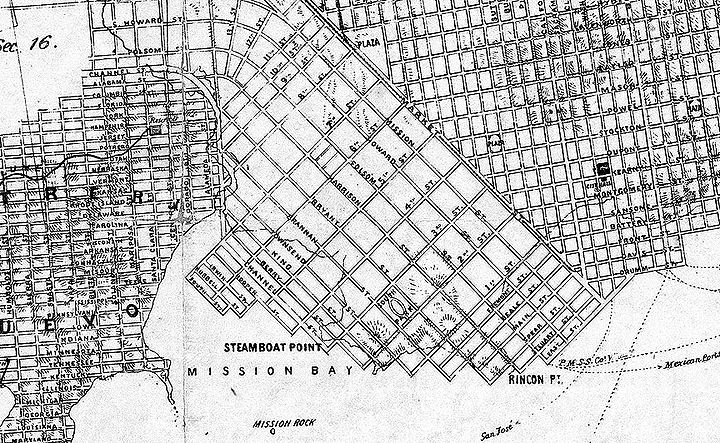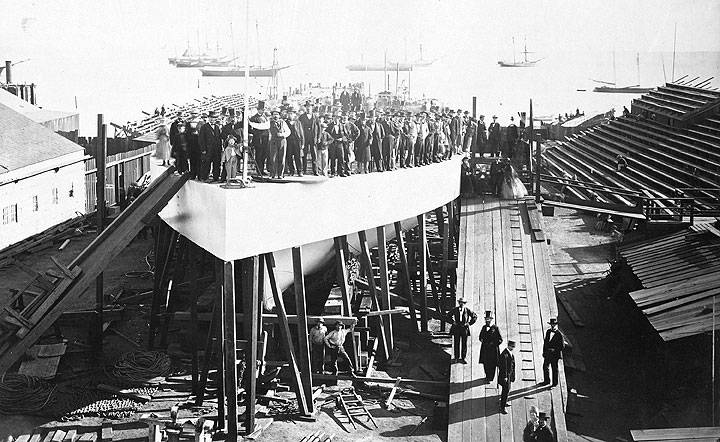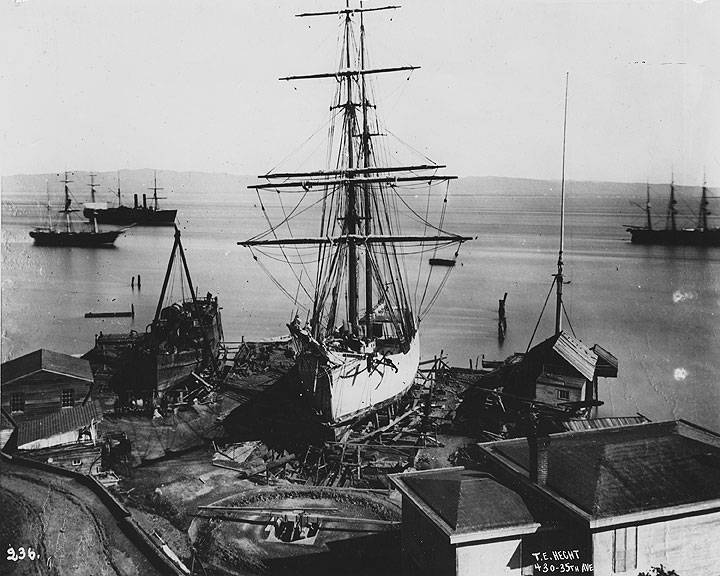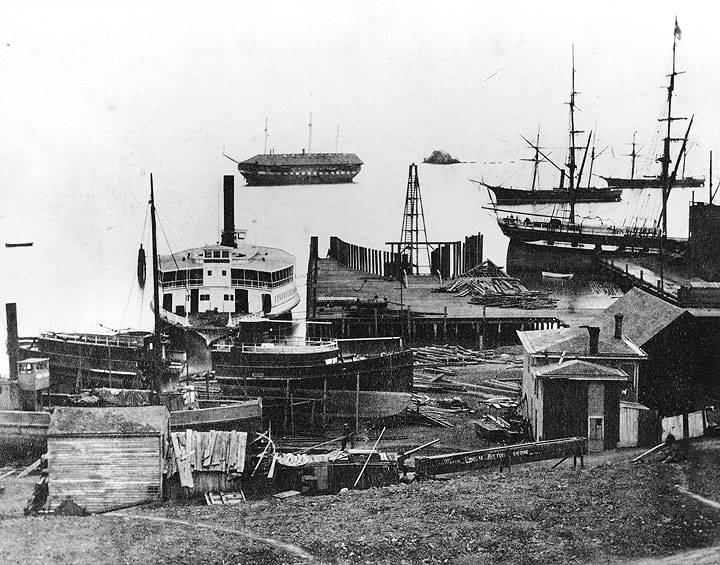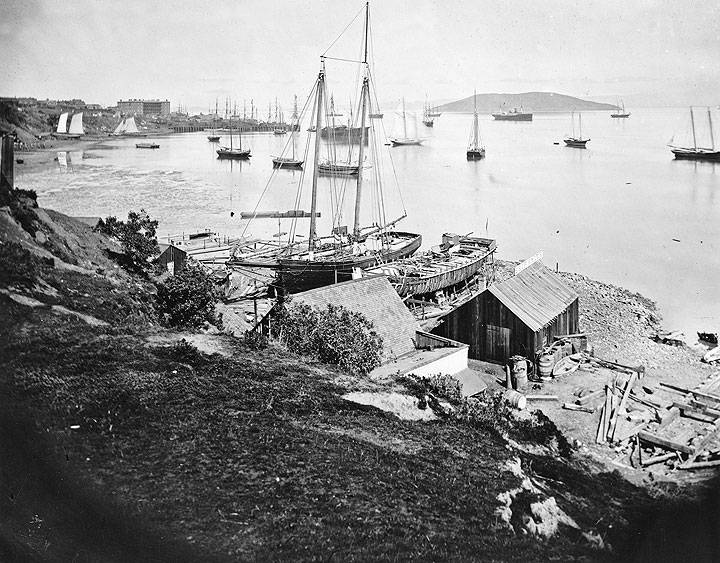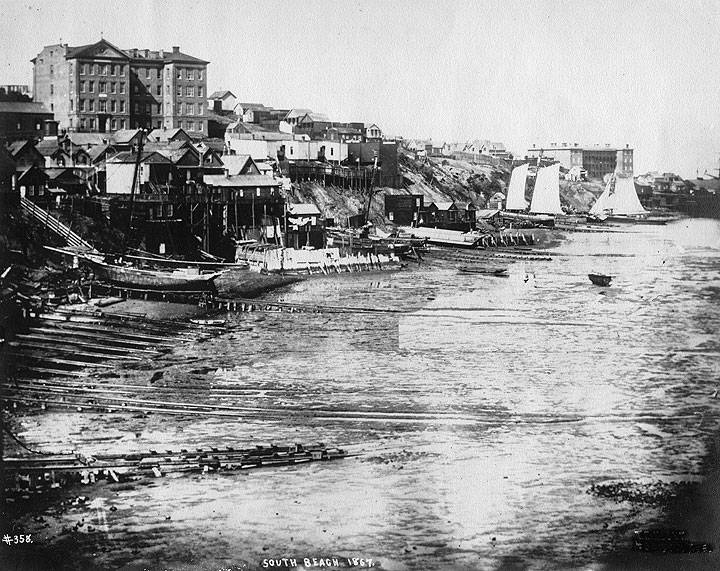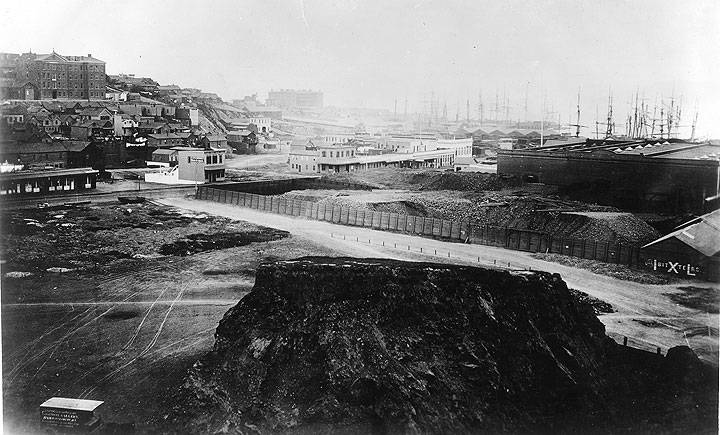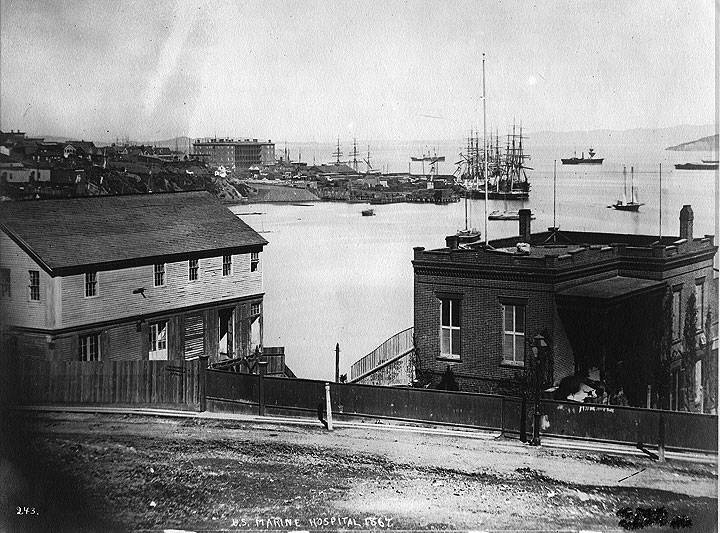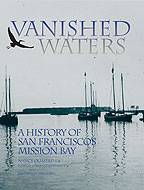Steamboat Point, 1851-1864
Historical Essay
by Nancy J. Olmsted
City and County of San Francisco. Compiled From Official Surveys And Sectionalized In Accordance With U.S. Surveys. Drawn By V. Wackenreuder, C.E. 1861. Published By Henry G. Langley For the San Francisco Directory.
Launching the Camanche, November 14, 1864: The monitor Camanche, shipped out from New Jersey in pieces, was put together at Third and King by mechanics of Peter Donahue’s Union Iron Works. Her armor plate was eleven inches thick around the turret. Her launching place is the site of one of John North’s earlier shipyards.
Photo: Bancroft Library (brk00000198_103a)
The most important early industry on Mission Bay gave its name to the point of land bounded by Second Street on the northeast, and just short of the line of Fourth Street on the southwest, with Townsend Street marking the edge of the bay in 1852.
By 1851, although there were suddenly hundreds of vessels of all sizes and types operating in and out of San Francisco, the city had no facility for hauling or drydocking vessels for bottom-cleaning, caulking, coppering or other repairs below the waterline. To meet this obvious need, Henry B. Tichenor constructed a marine railway at the foot of Second Street in 1851. Then as now, a marine railway consisted of tracks laid out into the water from above the high-tide line. To haul a vessel out of the water, it was maneuvered onto a stout iron-wheeled cradle that was drawn up the inclined railway by a windlass or capstan. Tichenor’s lot, partly land and partly water, with access to deep water close at hand, was ideally suited for ship repair.
Tichenor’s Ways, the Foot of Second Street. The marine railway at the foot of Second Street began operations in 1851. Ships coming onto these ways, such as the brigantine Hesperian, shown here in 1862, would be repaired and launched into the deep water beyond. Mules were used to turn the capstan—the large, circular device in the foreground—which hauled the ship up the ways and out of the water.
Photo: Bancroft Library (brk00012361_24a)
As early as 1849, knocked-down steamboats were being shipped to San Francisco from the East, to be put back together again on the beach at Happy Valley (from Market Street south to Rincon Point). Domingo Marcuci—who had come out with the pieces of the Captain Sutter and accompanying shipwrights, engineers, and captain—put the vessel together in six weeks at the foot of Folsom Street. Before long, in the early 1850s, he moved to Steamboat Point, around Fourth and King. Here he built the ships Reliance, Cyrus Walker, Flora Templeton and probably the barkentine Monitor. Later, from 1866 to 1869, he used Tichenor’s Second Street ways to build the sternwheeler Pioneer, the propellor Santa Cruz and the big steamer Vallejo'.
Tichenor’s Ways at the foot of Second St., San Francisco, 1868. The ferry is the Alameda, built 1866. The US Naval station ship Independence, in the background, was moored near Mission Rock 1867-1869.
Photo: San Francisco Maritime National Historical Park (A4.1,345pl)
John G. North established his boatyard at Steamboat Point about 1854 “on the south side of Townsend, between Third and Fourth.” The noblest vessel ever to be launched from Steamboat Point, the sidewheeler Chrysopolis, came from North’s yard in 1860, before he moved to the Potrero. She was the biggest steamer ever built at San Francisco up to that date, the grandest of the floating palaces of the California river trades and the all-time speed queen of the Sacramento riverboats. North is said to have built 53 steamboats and 220 vessels of other types, including the first three-masted schooner on the Pacific Coast, the Susan and Kate Dellin, launched at Steamboat Point in 1854.73
Another famous and prolific Steamboat Point builder was Patrick Henry Tiernan, one of whose earliest jobs at San Francisco involved converting the steamer Goliath to tugboat service at Steamboat Point. At Third and King between 1856 and 1858, Tiernan built the sidewheeler Paul Pry, the sternwheeler Peytonia, and the steamers Petaluma and Sophia McLean. Around Fourth and Townsend between 1859 and 1861, he built the sternwheelers Visalia and Swallow and the sidewheelers Sacramento and Oakland. Apparently moving back and forth between a Fourth Street and Third Street location, he built in 1862-1864 the steamers Banner, Esmeralda, Governor Dana and Julia, together with a number of barges. Then he, too, moved out to the Potrero, complaining, as had North, that Steamboat Point didn’t have enough elbowroom anymore. In 1870 he revisited the foot of Second Street to supervise the building of the Southern Pacific’s huge railroad-car ferry Thoroughfare.74
Tichenor’s Ways, 1865. Not much more than a narrow shelf of pebbled beach with a few tool houses, but H.B. Tichenor made his fortune at Steamboat Point and sold this lot for a 1000% profit to the Central Pacific. In distance at left at the northern end of South Beach is the old Marine Hospital. Out in the bay is Goat Island (now Yerba Buena Island).
Photo: San Francisco Maritime National Historical Museum (A12.240,324pl)
Although no photographs of Steamboat Point in the Gold Rush period have thus far appeared, photographs from the early 1860s give us a very good idea of what shipbuilding involved. It must be emphasized that these early shipbuilders constructed even the largest class of riverboats—equivalents of the floating palaces on the Mississippi and Hudson rivers—in starkly unimproved surroundings. All that was required for a “shipyard” was proximity to water and a sliver of flat land big enough to set up a vessel.
Materials and craftsmen and the “master builder” were really what constituted a shipyard. Steamboat Point is important to the rest of Mission Bay’s development in this period of the 1850s because ships were the carriers of all the city’s trade. It was at Steamboat Point that they were repaired and built as major capital investments by the city’s most prominent citizens. Important men, on important business—commission merchants, brokers, traders and sea captains—dropped in to oversee the building and repair of their ships. It was at John North’s yard, for example, that William Ralston, the city’s biggest banker who lent money to the men who built many of San Francisco’s industrial enterprises, had his favorite yacht, the Brisk, cut in two and lengthened.
San Francisco’s capitalists clearly understood, “The city will be forced to spread over the extensive and comparatively level tract of ground lying to the southwest, on the banks of Mission Creek, and in the direction of Mission Dolores. Perhaps not many years hence the whole shores of North Beach and South Beach, Mission Bay, and the Bay itself will be covered with streets and houses, quays and long piercing piers. . . . existing surveys. . . already exhibit these places, both on land and sea, divided and fairly mapped out into streets and wharves. ”75
South Beach, 1867. (top) Looking northeast.
Photo: California Historical Society (CHS2010.288)
San Francisco South Beach waterfront, early 1870s. Carleton Watkins took this shot looking northeast along South Beach just a few years after the photo above. South Beach is already filling in, the wharves are extending well into the bay. The Marine Hospital is visible in mists down the waterfront, while in the foreground a major piece of Rincon Hill has already been leveled.
Photo: California Historical Society (CHS2010.289)
Marine Hospital at Rincon Point, 1867. (top) California Historical Society (CHS2010.285)
This is chapter seven of "Vanished Waters: A History of San Francisco's Mission Bay" published by the Mission Creek Conservancy, and republished here with their permission.
NOTES
73. North, E.M. “Evolution of Shipping and Shipbuilding in California.” Overland Monthly, February, 1880: 143153.
74. Roger R. and Nancy Olmsted, San Francisco Waterfront (San Francisco: San Francisco Clean Water Program, 1976), 167-168.
75. Soule et al, The Annals of San Francisco, 160.

